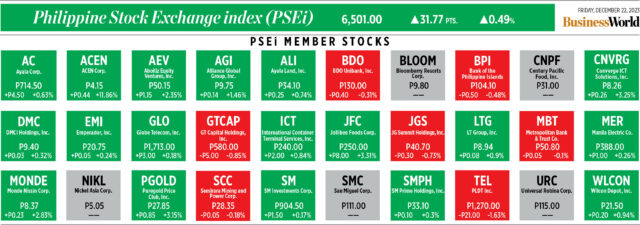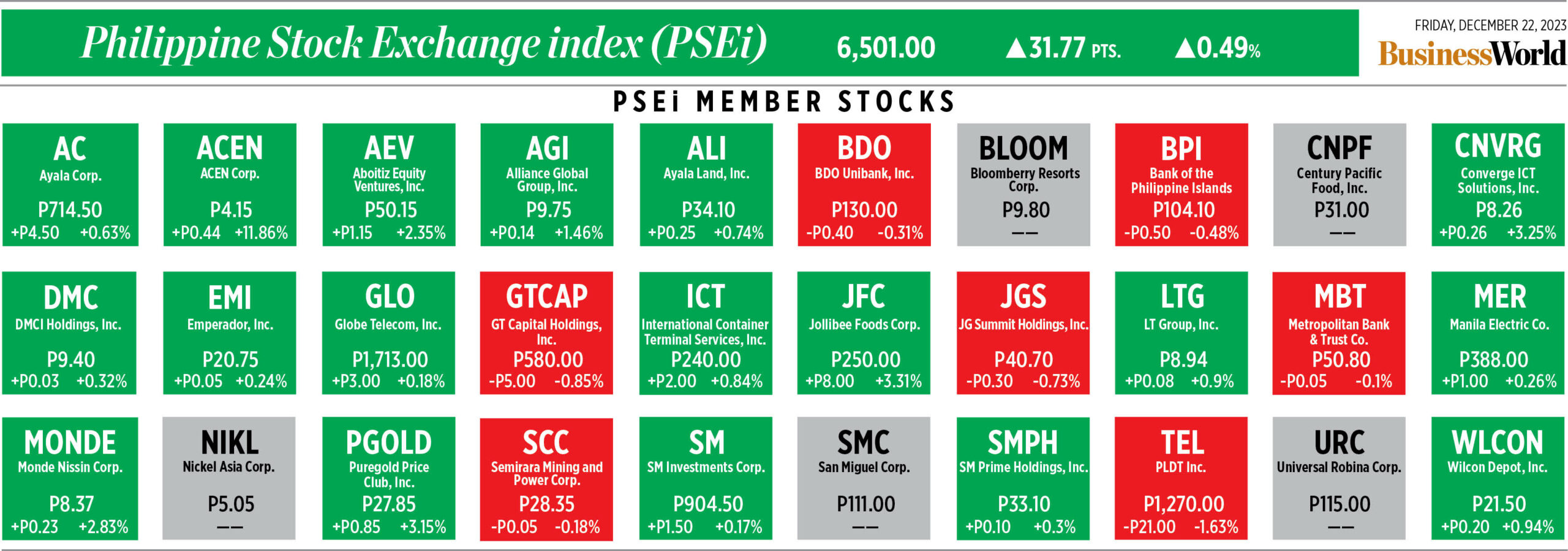By Joseph L. Garcia, Senior Reporter
THE YEAR 2023 was the first year since the lockdowns of 2020 when businesses in the Philippines were free from pandemic-related restrictions. These included limited operating hours, limited occupancy, and, for some businesses deemed nonessential in the very early days of the pandemic, closure.
In that period, malls treaded carefully. Quarantine passes, and later, vaccine cards had to be presented at doors, and only a limited number of shoppers could be accommodated at one time, forming long lines, or else the businesses had to completely turn away potential customers.
BusinessWorld asked for insights of two of the largest mall operators in the country on their first year of restriction-free operations. Ayala Malls — under Ayala Land, Inc., which is itself under the larger Ayala Corp. umbrella (which has interests in banking, telecommunications, energy; among others) — operates more than 30 malls across the country, including several in the National Capital Region, reaching across to the Visayas and Mindanao with several more properties. Robinsons Malls, meanwhile, is the second-largest mall operator, with over 50 malls in the country. It has properties as far up the northern region with Robinsons Place La Union, all the way down to Mindanao’s Iligan. Robinsons Malls is one of the business units of Robinsons Land Corp. (RLC), itself under JG Summit Holdings, Inc.
According to Robinsons Malls website, its establishments generate over 120 million visits annually. Meanwhile, Ayala Land’s annual report for 2022 says that “footfall and tenant sales exceeded pre-COVID levels, reaching 108% and 110%, respectively” in Q4 in 2022. “This significant improvement brought the average footfall and tenant sales to 87% of 2019 levels,” said the report. For this year, Clavel Tongco (Head of Operations, Ayala Malls), Mark Sablan (Head of Leasing, Ayala Malls), Lisa Yang (Marketing Director, Ayala Malls), told BusinessWorld in a joint e-mail, “We are pleased to confirm that we have successfully recovered to pre-pandemic levels in terms of foot traffic and sales.
“Our malls are once again bustling with activity, and we are delighted to witness a resurgence in people returning to the malls for their shopping needs,” they said. “This positive trend indicates a renewed confidence among our patrons, reflecting their eagerness to engage in the vibrant and diverse retail experiences our malls offer.”
Meanwhile, Robinsons Land’s annual report for 2022 says that their footfall and occupancy rates are nearing pre-pandemic levels. For 2023, Joel S. Lumanlan, Robinsons Malls Vice-President for Operations, Marketing, and Business Development told BusinessWorld, “Robinsons Malls’ rental revenues experienced a 32% increase, propelled by strong consumer spending and the normalization of business operations nationwide.” That figure is 6% above pre-pandemic levels.
BIGGER, BETTER?
Because malls had to adjust to less foot traffic during the pandemic, a possible scar would be smaller spaces for fewer people. But because of a post-pandemic surge in business, that may not have to be the case.
According to its 2022 Annual Report, Ayala Malls completed 7,000 sqm of gross leasable area (GLA) in 2022 with the opening of The Shops at Ayala Triangle. As of 2022’s end, their total GLA was 2.1 million sqm. “Bigger is still better when it comes to building mall space,” they told BusinessWorld. “A larger mall space allows us to offer a wider array of retail options, dining experiences, entertainment facilities, and community spaces, thereby enhancing the overall shopping experience for our patrons.
“This strategic focus on creating spacious and comprehensive mall spaces aligns with our commitment to staying at the forefront of evolving consumer preferences and industry trends, ensuring that Ayala Malls remains a preferred destination for both tenants and visitors,” they continued.
As for Robinsons Malls, in 2022, they opened three new malls (including one in Gapan, Nueva Ecija), and expanded two other malls, including their property in Antipolo, Rizal. “Yes, the bigger the better,” said Maria Kristina Real-Lim, Robinsons Malls Vice-President for Leasing. Mr. Lumanlan however, added, “The choice of the size of mall to build depends on a lot of factors including the market, economic, and competitive profile in an area and the property that is available for the developer to build on.”
GOING ONLINE
When malls operations were limited during the pandemic, the mall operators’ online arms reached out for customers. Robinsons retail units like its supermarkets and department stores jumped into online platforms such as Grab, Shopee, and Lazada, as well as maintaining its department store’s website. “Given the acceleration of digitalization in the industry post pandemic, the online platforms became more relevant and more important especially the video sharing, payment systems, and social networking platforms,” said Ms. Real-Lim. Mr. Lumanlan, agreed, saying, “With consumer shopping habits evolving, it’s important to reach, interact with and engage customers across different channels and platforms.”
Ayala Malls, however, reminded BusinessWorld: “We don’t have our own retail store, unlike our competitors,” they said. “Unlike some competitors who operate their own retail stores, Ayala Malls functions as a facilitator for various brands and retailers.”
However, they continued: “Recognizing the evolving retail landscape, we acknowledge the ongoing importance of online platforms. Ayala Malls views online channels as complementary to our mall-based business.”
During the pandemic, they had the Ayala Malls Neighborhood Assistant (nicknamed ANA) as a sort of a personal shopper service. The complementary services of their online arm includes today its Ayala Malls Zing App, which serves as a loyalty program.
Both entities opined on the continued importance of malls in a post-pandemic world. While online shopping may be here to stay, the age-old practice of choosing items by yourself seems to be indelible. However, the mall operators conclude that being in the mall just to buy things is no longer enough, and every visit should have value added to it, perhaps with added and amplified experiential factors.
“Consumer journeys continue to evolve and the malls are adapting well to the changes by introducing more experiential, differentiated, and wider range of options for shoppers,” said Mr. Lumanlan. “The pandemic-evolved Pinoy shopper is more empowered so it’s very important that we focus on customer experience in providing convenience and customer satisfaction,” said Ms. Real-Lim.
For Robinsons Malls, these include the evolution of their spaces beyond retail to be entertainment hubs with “experiential installations,” dining options, art exhibits, and other leisurely activities. While malls had already been used as government-service hubs, the use of mall space for these activities accelerated by the pandemic. “Malls also are now more actively engaging the local communities through government services, community events, etc.; nurturing the relationship between retail and the local area where the mall is located in,” said Mr. Lumanlan.
For Ayala Malls, they discussed their various holiday-related events that keep shoppers captivated, as well as the traditional holiday sales, and even CSR efforts such as community exchange gift activities and opportunities for shoppers to pledge money to children’s charities. “While the convenience of online shopping has become a significant aspect of consumer behavior, Ayala Malls recognizes the evolving landscape and remains committed to providing engaging, community-centric, and immersive experiences that go beyond the transactional nature of e-commerce,” they said.
Malls have become our main cultural and social centers — more than museums, parks, libraries, and other such spaces. There is an enduring importance of the mall, despite shifts in consumer behavior. Malls, apparently, are less a retail space in the Filipino psyche, but are instead an important pillar in building a community.
“Consumer behavior has shown a preference for community-centric spaces. Ayala Malls, with its emphasis on creating vibrant and social environments, taps into the Filipino culture of malls being gathering places. This aligns with the desire for not just shopping but also socializing, dining, and engaging in cultural experiences,” they said. “Our malls continue to be an integral part of the retail ecosystem, offering a dynamic and social shopping environment that complements the convenience of online platforms.”
“Shopping in a mall remains to be an important social activity,” said Robinsons’ Mr. Lumanlan. “One can go shopping with families or friends and enjoy spending time together while going around the stores, try on stuff being sold, dine in exciting food outlets and these cannot be easily replicated online. It’s also great way to bond, meet new people, build new friendships and create more memories.” His colleague Ms. Real-Lim, agrees: “Malls are important in nurturing communities as we bring people together in malls in ways e-commerce cannot.”

















